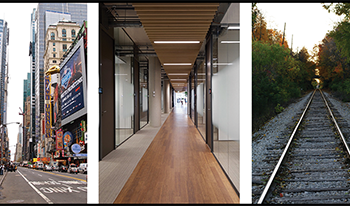References
1LiA.ZaidiQ.2000Perception of three-dimensional shape from texture is based on patterns of oriented energyVis. Res.40217242217–4210.1016/S0042-6989(99)00169-8
2BülthoffH. H.YuilleA. L.SchenkerP. S.1991Shape-from-X: Psychophysics and computationSensor Fusion III: 3D Perception and Recognition235246235–46International Society for Optics and Photonics
3NakayamaK.ShimojoS.1992Experiencing and perceiving visual surfacesScience257135713631357–6310.1126/science.1529336
4LikovaL. T.TylerC. W.2003Peak localization of sparsely sampled luminance patterns is based on interpolated 3D object representationsVis. Res.43264926572649–5710.1016/S0042-6989(02)00575-8
5LandyM. S.MaloneyL. T.JohnstonE. B.YoungM.1995Measurement and modeling of depth cue combination: In defense of weak fusionVis. Res.35389412389–41210.1016/0042-6989(94)00176-M
6MaloneyL. T.LandyM. S.1989A statistical framework for robust fusion of depth informationSPIE Proc.1199115411641154–64
7GregoryR. L.1963Distortion of visual space as inappropriate constancy scalingNature199678680678–8010.1038/199678a0
8GregoryR. L.1980Perceptions as hypothesesPhil. Trans. Royal Soc. Lond. Biological Sciences B290181197181–9710.1098/rstb.1980.0090
9ErkelensC. J.2015The extent of visual space inferred from perspective anglesi-Perception65145–1410.1068/i0673
10TylerC. W.KontsevichL. L.1995Mechanisms of stereoscopic processing: stereoattention and surface perception in depth reconstructionPerception24127153127–5310.1068/p240127
11TylerC. W.2004Theory of texture discrimination based on higher-order perturbation in individual texture samplesVis. Res.44217921862179–8610.1016/j.visres.2004.03.029
12SuC. C.CormackL. K.BovikA. C.
13SunJ.ZhengN. N.ShumH.-Y.2003Stereo matching using belief propagationIEEE Trans. Pattern Anal. Mach. Intell.25787800787–80010.1109/TPAMI.2003.1206509
14PotetzB.LeeT. S.2003Statistical correlations between 2D Images and 3D structures in natural scenesJ. Opt. Soc. Am. A20129213031292–30310.1364/JOSAA.20.001292
15JuleszB.MillerJ. E.1991Automatic stereoscopic presentation of functions of two variablesBell Syst. Tech. J.41663676663–7610.1002/j.1538-7305.1962.tb02424.x
16LandyM. S.MaloneyL. T.YoungM. J.SchenkerP. S.Psychophysical estimation of the human depth combination ruleSensor Fusion III: 3D Perception and Recognition1991International Society for Optics and Photonics247255247–55
17YoungM. J.LandyM. S.MaloneyL. T.18A perturbation analysis of depth perception from combinations of texture and motion cuesVis. Res.33268526962685–9610.1016/0042-6989(93)90228-O
18OruçI.MaloneyL. T.LandyM. S.2003Weighted linear cue combination with possibly correlated errorVis. Res.43245124682451–6810.1016/S0042-6989(03)00435-8
19JohnstonE. B.CummingB. G.LandyM. S.1994Integration of stereopsis and motion shape cuesVis. Res.34225922752259–7510.1016/0042-6989(94)90106-6
20JuleszB.Foundations of Cyclopean Perception1971U. Chicago PressOxford, England
21SayeA.FrisbyJ. P.1975The role of monocularly conspicuous features in facilitating stereopsis from random-dot stereogramsPerception4159171159–7110.1068/p040159
22SamondsJ. M.TylerC. W.LeeT. S.
23GoryoK.KikuchiT.1971Disparity and training in stereopsisJapan. Psychological Res.13148152148–5210.4992/psycholres1954.13.148
24MacCrackenP. J.BourneJ. A.HayesW. N.1977Experience and latency to achieve stereopsis: A replicationPerceptual and Motor Skills45261262261–210.2466/pms.1977.45.1.261
25TrommershauserJ.KordingK.LandyM. S.Sensory Cue Integration2011Oxford University PressOxford
26GoldsteinE. B.BrockmoleJ.Sensation and Perception201610th ed.Cengage LearningBoston MA
27ChenC. C.TylerC. W.2015Shading beats binocular disparity in depth from luminance gradients: Evidence against a maximum likelihood principle for cue combinationPLoS One10e013265810.1371/journal.pone.0132658
28YuilleA. L.BülthoffH. H.KnillD. C.RichardsW.1995Bayesian decision theory and psychophysicsBayesian Perspectives on Visual PerceptionCambridge University PressCambridge
29SaundersJ. A.ChenZ.
30GogelW. C.1969
31BelhumeurP. N.KriegmanD.YuilleA. L.1999The bas-relief ambiguityInt. J. Comput. Vis.35334433–4410.1023/A:1008154927611
32TylerC. W.GopiA.Computational estimation of scene structure through texture gradient cuesIS&T Electronic Imaging: Human Vision and Electronic Imaging2017IS&TSpringfield, VA167176167–76

 Find this author on Google Scholar
Find this author on Google Scholar Find this author on PubMed
Find this author on PubMed